Assessing the Competitiveness of the Ski Resources around Lake Baikal (Russia) and Measures for Their Further Development
Abstract
1. Introduction
2. Research Area Overview
3. Research Methods
3.1. Comprehensive System of Indicators for Assessing the Competitiveness of Ski Resorts
3.2. Evaluation Model Construction
- (1)
- Entropy method
- (2)
- Expert interval scoring method
- (3)
- The calculation of the comprehensive evaluation score is as follows:
4. Results
4.1. Assessment of the Competitive Advantages of Natural Conditions
4.2. Assessment of the Competitive Advantages of Tourism Resources
4.3. Assessment of the Competitive Advantages of Government and Public Support
4.4. Assessment of the Competitive Advantages of the Scope of Services Provided and Their Management
4.5. Assessment of the Competitive Advantages of Infrastructure Construction
5. Discussion
6. Conclusions and Recommendations
- (1)
- Russian authorities could optimize the model of ice and snow tourism development around Lake Baikal and make it more competitive. The five major resorts should make better use of their strengths while addressing and improving their weaknesses. The establishment of an international demonstration zone for green and low-carbon ice and snow tourism could be considered, including the coordinated development of the five resorts, with the Sobolinaya resort as the core.
- Based on the evaluation results presented in this article, it is recommended to adopt a model for the development of ice and snow tourism around Lake Baikal based on competition and cooperation in the tourism sector within the China–Mongolia–Russia economic corridor. The creation of an international demonstration zone for green and low-carbon ice and snow tourism could be an important project within this model.
- In order to take full advantage of the natural conditions, the Baikal International Ice and Snow Resort could be built, including the Sobolinaya Resort (as the core) and the Mamai Resort.
- The ski resorts of Istlend and Bychya are already effectively using their geographical advantages and are developing in cooperation with the capitals of Irkutsk Oblast and Buryatia, respectively. They contribute to the development of winter tourism in both regions along the western and eastern shores of Lake Baikal.
- The Davan ski resort has the potential to develop unique tourism and wellness projects in the northern region of Lake Baikal, capitalizing on the health benefits of both winter tourism and hot springs.
- (2)
- China could actively adopt the experience of unique Russian projects in the field of winter tourism related to extreme sports and nature tourism to enrich its own experience and improve the model of ice and snow tourism development.
- The development of ice and snow tourism in modern China has started relatively recently and is mainly associated with leisure and recreation, with insufficient resources for extreme sports.
- The unique climate and topography of Lake Baikal have created an ice and snow culture among the local population, which is not only engaged in leisure activities but also in economic activities.
- In contrast to the Chinese ice and snow entertainment events, the five main ski resorts around Lake Baikal have their own distinct tourism advantages and projects.
- The development models of the five main ski resorts around Lake Baikal are different and have distinctive features. For example, the natural conditions, government support, and infrastructure construction of the Sobolinaya resort create obvious competitive advantages.
- The natural conditions of the Mamai ski resort are the most competitive, with the peculiarity of free skiing.
- The wide range of services offered by the Istland ski resort (with a focus on water and ice projects and recreation) has clear advantages.
- The Bychya resort focuses on mass tourism and entertainment for urban residents, while the extreme sports and remote location of Davan attract a different category of tourists.
- (3)
- Building on the Belt and Road Initiative, China and Russia could better utilize the complementary bilateral advantages of the two countries to jointly implement the strategy of ice and snow tourism and establish a green, low-carbon international ice and snow tourism zone within the China–Mongolia–Russia economic corridor.
- China’s “Belt and Road” initiative, the construction of the “Ice Silk Road”, the formation of the Russian-led Eurasian Economic Union, and Mongolia’s “Path to Pasture” initiative are all aimed at deepening cross-border tourism cooperation.
- As important partners, China and Russia have an important platform to exchange experience and cooperate in the development of winter sports between the two countries.
- China and Russia could take advantage of the construction of the China–Mongolia–Russia economic corridor to enhance cooperation in winter tourism and seize the opportunities presented by the 2022 Beijing Winter Olympic Games.
- China could actively cooperate with Russia in establishing a green and low-carbon international special zone for ice and snow tourism along the China–Mongolia–Russia economic corridor.
- The special zone for ice and snow tourism could have a special support policy, including measures such as expedited customs clearance, 72 h visa-free entry, and the establishment of duty-free shops. This would help improve accessibility for tourists from China and other countries.
- As ice and snow tourism is a driving regional industry, the Baikal International Winter Tourism Festival could contribute to the creation of an international winter tourism brand on the shores of Lake Baikal and deepen regional cooperation within the China–Mongolia–Russia economic corridor.
- (4)
- Further comparative research on the competitiveness of ski tourism in different regions is needed, with a focus on sustainability issues. In addition, it is necessary to improve the system of competitiveness assessment indicators, promote cross-integration between ski tourism and cultural tourism, rural tourism, tourism geography, etc., and contribute to the further development of ecotourism disciplines.
- Comparative research on the competitiveness of ski resorts in different regions, such as the Baikal and Altai regions, Sino-Russian border regions, and others, can be an important direction. This research aims to explore each other’s strengths and provide theoretical support for deepening regional cooperation and cross-border cooperation.
Author Contributions
Funding
Institutional Review Board Statement
Informed Consent Statement
Data Availability Statement
Conflicts of Interest
References
- Tulokhonov, A.K.; Tulokhonov, S.A. Contradictions in Environmental Legislation (Regional Aspect). In Proceedings of the Interregional Conference “Legislation of the Constituent Entities of the Russian Federation: Experience, Problems, Ensuring a Unified Legal Space in the Country”, Ulan-Ude, Russia, 20–21 June 2001; pp. 309–315. [Google Scholar]
- Tugolukov, V.A. Pathfinders Riding on Reindeer; Nauka: Moscow, Russia, 1969; p. 215. [Google Scholar]
- Sun, J.; Dong, S. The Sustainable Development of Northeast Asia and Central Asia; Science Press: Beijing, China, 2017; p. 572. [Google Scholar]
- National Development and Reform Commission. Building the China-Mongolia-Russia Economic Corridor. Available online: https://www.ndrc.gov.cn (accessed on 3 May 2023).
- Garmaev, E.Z.; Tsydypov, B.Z.; Andreev, S.G.; Ayurzhanaev, A.A.; Alymbaeva, Z.B.; Batotsyrenov, E.A.; Sodnomov, B.V.; Zharnikova, M.A. Features of the natural environment of the Tea Road corridor in the context of the climate change. In Proceedings of the First International Geographical Conference of North Asian Countries “China-Mongolia-Russia Economic Corridor: Geographical and Environmental Factors and Territorial Development Opportunities”, Irkutsk, Russia, 20–26 August 2018; pp. 1–9. [Google Scholar]
- Reshetnikov, A.F.; Fomin, V.A. How skiing emerged and became important to the ancients. Buryat State Univ. Bull. 2010, 13, 126–130. [Google Scholar]
- Malyavkin, A.G. Tang Dynasty Chronicles of the Central Asian Countries; Nauka, Sibirskoe Otdelenie: Novosibirsk, Russia, 1989; p. 435. [Google Scholar]
- Kharinsky, A.V. Cisbaikalia in End of the 1st Millennium BC—Middle 2nd Millennium AD: The Genesis of Cultures and Their Periodization; Irkutsk State Technical University Press: Irkutsk, Russia, 2001; p. 198. [Google Scholar]
- Alekseev, M.P. Siberia Described by Western European Travelers and Writers; Irkutsk Oblast Publishing House: Irkutsk, Russia, 1941; p. 609. [Google Scholar]
- Stankova, M.; Vasenska, I. Tourism destination competitiveness models. Tour. Travel. 2017, 1, 58–64. [Google Scholar] [CrossRef]
- Lars, R.; Morten, F. Spatial Development Follows Digitization. In Mobilities, Tourism and Travel Behavior; Leszek, B., Ed.; IntechOpen: Rijeka, Croatia, 2017; Chapter 12. [Google Scholar]
- The Travel & Tourism Competitiveness Report 2009. Available online: https://www3.weforum.org/docs/TTCR09/ (accessed on 2 July 2023).
- Porter, M.; Cornelius, P.; Sachs, J.; Levinson, M.; Warner, A.; Schwab, K. The Global Competitiveness Report 2000; Oxford University Press: Oxford, UK, 2004. [Google Scholar]
- Gooroochurn, N.; Sugiyarto, G. Competitiveness Indicators in the Travel and Tourism Industry. Tour. Econ. 2005, 11, 25–43. [Google Scholar] [CrossRef]
- Chon, K.S.; Mayer, K.J. Destination competitiveness models in tourism and their application to Las Vegas. J. Tour. Syst. Qual. Manag. 1995, 1, 227–246. [Google Scholar]
- Faulkner, B.; Oppermann, M.; Fredline, E. Destination competitiveness: An exploratory examination of South Australia’s core attractions. J. Vacat. Mark. 1999, 5, 125–139. [Google Scholar] [CrossRef]
- Hudson, S.; Ritchie, B.; Timur, S. Measuring destination competitiveness: An empirical study of Canadian ski resorts. Tour. Hosp. Plan. Dev. 2004, 1, 79–94. [Google Scholar] [CrossRef]
- Flit, A.L. Approaches to identifying and assessing factors of competitiveness in the tourism industry. Pushkin Leningrad State Univ. J. 2014, 1, 28–37. [Google Scholar]
- Razorenova, M.A. Evaluation and Formation of Competitiveness of Tourist and Sports Mountain Resort. Ph.D. Thesis, Sochi State University of Tourism and Resorts, Sochi, Russia, 2005. [Google Scholar]
- Lassi, M.Y. Analysis of approaches to assessing competitiveness of regional tourism in Russia. Baikal Res. J. 2017, 8, 24. [Google Scholar]
- Solodkov, M.V.; Borisova, A.O. Competitiveness of the Irkutsk region on the world market of tourist services. IKBFU’s Vestnik Hum. Soc. Sci. 2016, 3, 95–103. [Google Scholar]
- Băbăț, A.-F.; Mazilu, M.; Niță, A.; Drăguleasa, I.-A.; Grigore, M. Tourism and Travel Competitiveness Index: From Theoretical Definition to Practical Analysis in Romania. Sustainability 2023, 15, 10157. [Google Scholar] [CrossRef]
- Zhou, W. Evaluation on core competitiveness of skiing industry based on diamond model. J. Jianghan Univ. 2018, 46, 379–384. [Google Scholar]
- Han, G.; Zhang, S. Study on the competitiveness of ski tourism industry in Heilongjiang Province based on the diamond model. China Winter Sports 2013, 35, 73–76. [Google Scholar]
- Fang, Y.; Jiang, Y.; Tsai, C.-H.K.; Luo, B.; Chen, M.-H. Spatial Patterns of China’s Ski Resorts and Their Influencing Factors: A Geographical Detector Study. Sustainability 2021, 13, 4232. [Google Scholar] [CrossRef]
- Żemła, M. Winter Sports Resorts and Natural Environment—Systematic Literature Review Presenting Interactions between Them. Sustainability 2021, 13, 636. [Google Scholar] [CrossRef]
- An, H.; Xiao, C.; Ding, M. The Spatial Pattern of Ski Areas and Its Driving Factors in China: A Strategy for Healthy Development of the Ski Industry. Sustainability 2019, 11, 3138. [Google Scholar] [CrossRef]
- Polderman, A.; Haller, A.; Viesi, D.; Tabin, X.; Sala, S.; Giorgi, A.; Darmayan, L.; Rager, J.; Vidovič, J.; Daragon, Q.; et al. How Can Ski Resorts Get Smart? Transdisciplinary Approaches to Sustainable Winter Tourism in the European Alps. Sustainability 2020, 12, 5593. [Google Scholar] [CrossRef]
- Moreno-Gené, J.; Sánchez-Pulido, L.; Cristobal-Fransi, E.; Daries, N. The Economic Sustainability of Snow Tourism: The Case of Ski Resorts in Austria, France, and Italy. Sustainability 2018, 10, 3012. [Google Scholar] [CrossRef]
- Rygzynov, T.S.; Batomunkuev, V.S.; Gomboev, B.O.; Dong, S.; Sharaldaev, B.B.; Ayusheeva, V.G.; Badmaev, A.G.; Motoshkina, M.A.; Zangeeva, N.R.; Tsybikova, A.B.; et al. Efficiency of Transport Infrastructure in Asian Russia, China, Mongolia, and Kazakhstan in the Context of Creating New Trans-Eurasian Transport Corridors. Sustainability 2023, 15, 9714. [Google Scholar] [CrossRef]
- Carus, L.; Mamaqi-Kapllani, X. Managing Accident Prevention in Ski Resorts: Participants’ Actual Velocities in Slow Zones. Int. J. Environ. Res. Public Health 2023, 20, 5302. [Google Scholar]
- Duglio, S.; Beltramo, R. Environmental Management and Sustainable Labels in the Ski Industry: A Critical Review. Sustainability 2016, 8, 851. [Google Scholar] [CrossRef]
- Demiroglu, O.C.; Turp, M.T.; Ozturk, T.; Kurnaz, M.L. Impact of Climate Change on Natural Snow Reliability, Snowmaking Capacities, and Wind Conditions of Ski Resorts in Northeast Turkey: A Dynamical Downscaling Approach. Atmosphere 2016, 7, 52. [Google Scholar] [CrossRef]
- Vorkauf, M.; Steiger, R.; Abegg, B.; Hiltbrunner, E. Snowmaking in a warmer climate: An in-depth analysis of future water demands for the ski resort Andermatt-Sedrun-Disentis (Switzerland) in the twenty-first century. Int. J. Biometeorol. 2022; Online ahead of print. [Google Scholar] [CrossRef] [PubMed]
- Fischer, A.; Adolf, H.; Bender, O. Are the Skiing Industry, Globalisation, and Urbanisation of Alpine Landscapes Threatening Human Health and Ecosystem Diversity? In Biodiversity-Health-Sustainability Nexus in Socio-Ecological Production Landscapes and Seascapes (SEPLS); Nishi, M., Subramanian, S.M., Gupta, H., Eds.; Springer Nature: Singapore, 2022; pp. 151–175. [Google Scholar]
- Berard-Chenu, L.; Cognard, J.; François, H.; Morin, S.; George, E. Do changes in snow conditions have an impact on snowmaking investments in French Alps ski resorts? Int. J. Biometeorol. 2021, 65, 659–675. [Google Scholar] [CrossRef] [PubMed]
- Kulözü-Uzunboy, N.; Demiroglu, O.C. Climate Change Adaptation: Capacity Building for Winter Tourism in Western Asia. In Climate Action; Leal Filho, W., Azul, A.M., Brandli, L., Özuyar, P.G., Wall, T., Eds.; Springer International Publishing: Cham, Switzerland, 2020; pp. 1–14. [Google Scholar]
- Moscovici, D. Ski Resort Closures and Opportunities for Sustainability in North America. Land 2022, 11, 494. [Google Scholar] [CrossRef]
- Dragović, N.; Pašić, M. Sustainable Tourism in Ski Resorts of Europe and The World. In Proceedings of the SITCON 2020, Belgrad, Serbia, 9 October 2020; pp. 108–116. [Google Scholar]
- Mikloš, M.; Jančo, M.; Korísteková, K.; Škvareninová, J.; Škvarenina, J. The Suitability of Snow and Meteorological Conditions of South-Central Slovakia for Ski Slope Operation at Low Elevation—A Case Study of the Košútka Ski Centre. Water 2018, 10, 907. [Google Scholar] [CrossRef]
- Haugom, E.; Malasevska, I. The relative importance of ski resort- and weather-related characteristics when going alpine skiing. Cogent Soc. Sci. 2019, 5, 1681246. [Google Scholar] [CrossRef]
- Rutty, M.; Scott, D.; Johnson, P.; Jover, E.; Pons, M.; Steiger, R. The geography of skier adaptation to adverse conditions in the Ontario ski market. Can. Geogr. 2015, 59, 391–403. [Google Scholar] [CrossRef]
- Fischer, A.; Olefs, M.; Abermann, J. Glaciers, snow and ski tourism in Austria’s changing climate. Ann. Glaciol. 2011, 52, 89–96. [Google Scholar] [CrossRef]
- Bichler, B.F.; Pikkemaat, B. Winter sports tourism to urban destinations: Identifying potential and comparing motivational differences across skier groups. J. Outdoor Recreat. Tour. 2021, 36, 100420. [Google Scholar] [CrossRef]
- Suau-Sanchez, P.; Voltes-Dorta, A. Drivers of airport scheduled traffic in European winter tourism areas: Infrastructure, accessibility, competition and catchment area. J. Air Trans. Manag. 2019, 81, 101723. [Google Scholar] [CrossRef]
- Miragaia, D.; Conde, D.; Soares, J. Measuring Service Quality of Ski Resorts: An Approach to Identify the Consumer Profile. Open Sports Sci. J. 2016, 9, 53–61. [Google Scholar] [CrossRef]
- Schaffner, P. Public Transportation in Ski Towns: An Analysis for the Ski Town Workforce and Visiting Populations. Master’s Thesis, University of Pennsylvania, Philadelphia, PA, USA, 2021. [Google Scholar]
- Delibašić, B.; Radovanović, S.; Jovanović, M.Z.; Suknović, M. Improving Decision-Making in Ski Resorts by Analysing Ski Lift Transportation—A Review. In Advances in Operational Research in the Balkans; Springer: Berlin/Heidelberg, Germany, 2020; pp. 265–273. [Google Scholar]
- Bursa, B.; Mailer, M.; Axhausen, K.W. Travel behavior on vacation: Transport mode choice of tourists at destinations. Trans. Res. Part A: Policy Pract. 2022, 166, 234–261. [Google Scholar] [CrossRef]
- Kariel, H.G. Socio-Cultural Impacts of Tourism in the Austrian Alps. Mt. Res. Dev. 1989, 9, 59–70. [Google Scholar] [CrossRef]
- Podkalicka, A.; Strobl, P. Skiing Transnational: Cultures, Practices, and Ideas on the Move. In Leisure Cultures and the Making of Modern Ski Resorts; Strobl, P., Podkalicka, A., Eds.; Springer International Publishing: Cham, Switzerland, 2019; pp. 1–23. [Google Scholar]
- Bausch, T.; Unseld, C. Winter tourism in Germany is much more than skiing! Consumer motives and implications to Alpine destination marketing. J. Vacat. Mark. 2018, 24, 203–217. [Google Scholar] [CrossRef]
- Nejati, M.; Mohamed, B.; Omar, S.I. Environmental Impacts of Tourism on Locals’ Perceived Importance of Sustainable Tourism. Tour. An Int. Multidiscip. J. Tour. 2014, 9, 147–160. [Google Scholar]
- Tang, C.; Xu, S. Sustainable Development of Ice and Snow Tourism—Theory & Empirical Studies: Preface. J. Resour. Ecol. 2022, 13, 545, 547–551. [Google Scholar]
- Cristobal-Fransi, E.; Daries, N.; Serra-Cantallops, A.; Ramón-Cardona, J.; Zorzano, M. Ski Tourism and Web Marketing Strategies: The Case of Ski Resorts in France and Spain. Sustainability 2018, 10, 2920. [Google Scholar] [CrossRef]
- Curcic, N.; Milinčić, U.; Stranjančević, A.; Milinčić, M. Can winter tourism be truly sustainable in natural protected areas? J. Geogr. Inst. Jovan Cvijic SASA 2019, 69, 241–252. [Google Scholar] [CrossRef]
- Chen, T.; Yu, H.; Wang, F. Research on ecotourism development in China: Moving towards the goal of sustainability. J. Chin. Ecotour. 2021, 11, 78–94. [Google Scholar] [CrossRef]
- Li, Y.; Zhao, M.; Guo, P.; Zheng, J.; Li, Z.; Li, F.; Shi, Y. Comprehensive evaluation of ski resort development conditions in northern China. Chin. Geogr. Sci. 2016, 26, 401–409. [Google Scholar] [CrossRef]
- Liu, C.; You, S.; Wu, S.; Chen, H.; Juan, Y. The construction of evaluation index system for choosing coastal homestay inn cluster locations using Q method. J. Chin. Ecotour. 2021, 11, 631–643. [Google Scholar] [CrossRef]
- Wang, Z.; Jiang, Y.; Hong, P.; Wang, N.; Zhang, Y.; He, D. Literature review of sport tourism based on research abroad. J. Chin. Ecotour. 2021, 11, 176–189. [Google Scholar] [CrossRef]
- Alekseeva, A.R.; Den, V.G. Opportunities for the development of ski tourism in the Kamchatka region. In Proceedings of the Current Trends and Technologies of Regional Capacity Development, Saint-Petersburg, Russia, 20 April 2022; pp. 130–136. [Google Scholar]
- Vasilyeva, R.R. Tourism in Russia: From Kamchatka to Kaliningrad (or why Russia is one of the most potentially popular countries for tourism in the world). In Proceedings of the Science and Education to Solve Today’s Global Problems, Sterlitamak, Russia, 14 February 2022; pp. 119–123. [Google Scholar]
- Chkhotua, I.Z. Strategic priorities for the development of ski tourism in the world and in Russia. Russia’s Econ. Revival 2022, 2, 123–136. [Google Scholar] [CrossRef]
- The Baikal Information Center. Lake Baikal Basin Borders and Structure Map. Available online: http://bic.iwlearn.org/en/atlas/atlas/03-lake-baikal-basin-borders-and-structure-map (accessed on 3 May 2023).
- Garmaev, E.Z.; Khristoforov, A.V. Water Resources of the Rivers of the Lake Baikal Basin: The Basics of Their Use and Protection; Geo: Novosibirsk, Russia, 2010; p. 227. [Google Scholar]
- UNESCO World Heritage Convention. Lake Baikal. Available online: http://whc.unesco.org/en/list/754 (accessed on 3 May 2023).
- Mekush, G.E.; Ushakovа, Е.О. Study of the competitiveness of ski resorts in the Siberian region (the example of Kemerovo region). In Proceedings of the Youth, Sports and Health Tourism: Current Status and Development Prospects, Sochi, Russia, 18–20 May 2016; pp. 199–203. [Google Scholar]
- Bukher, S. Competitiveness of the Russian Federation in the global tourism market. Econ. Regions 2016, 12, 240–250. [Google Scholar] [CrossRef]
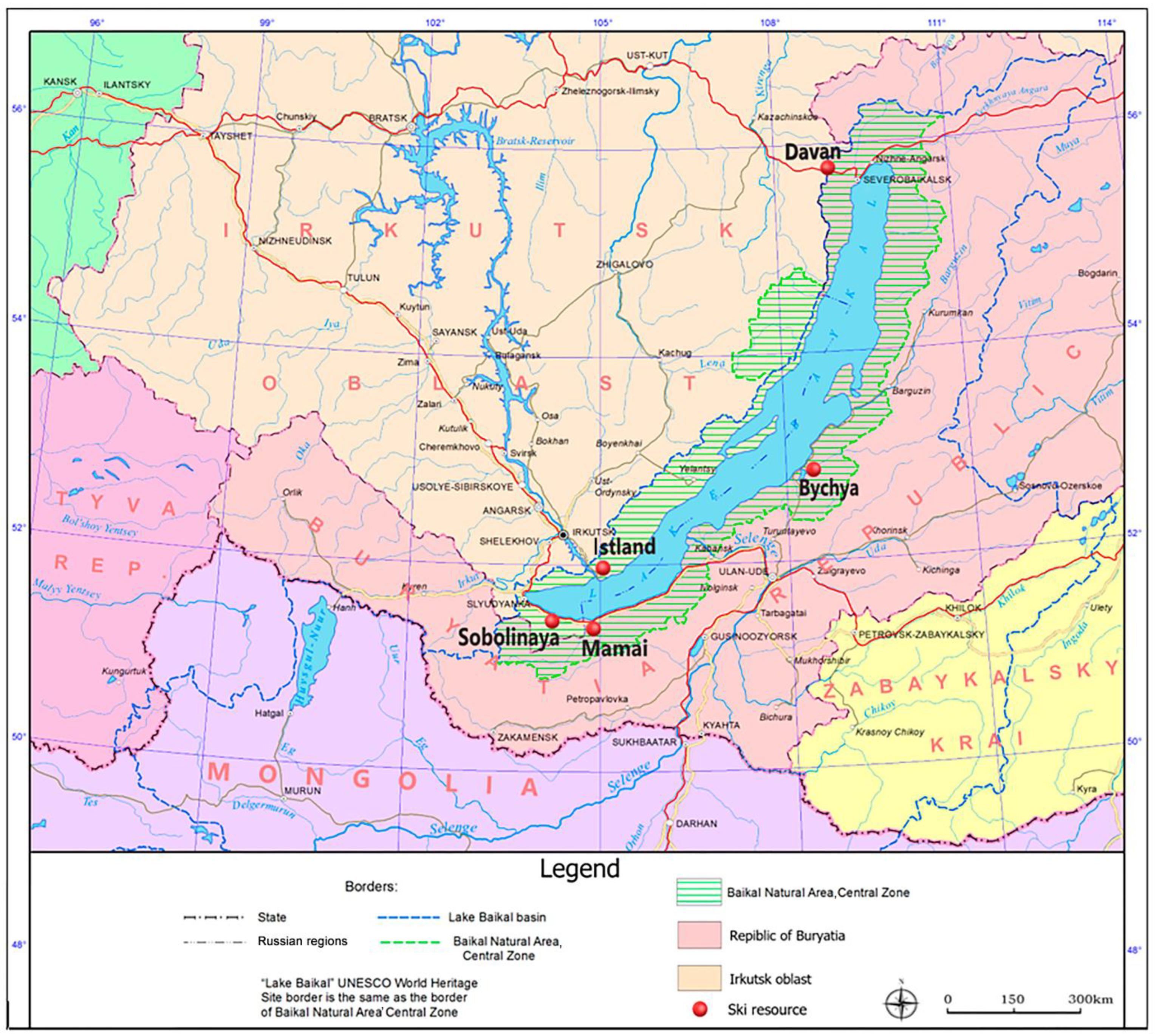

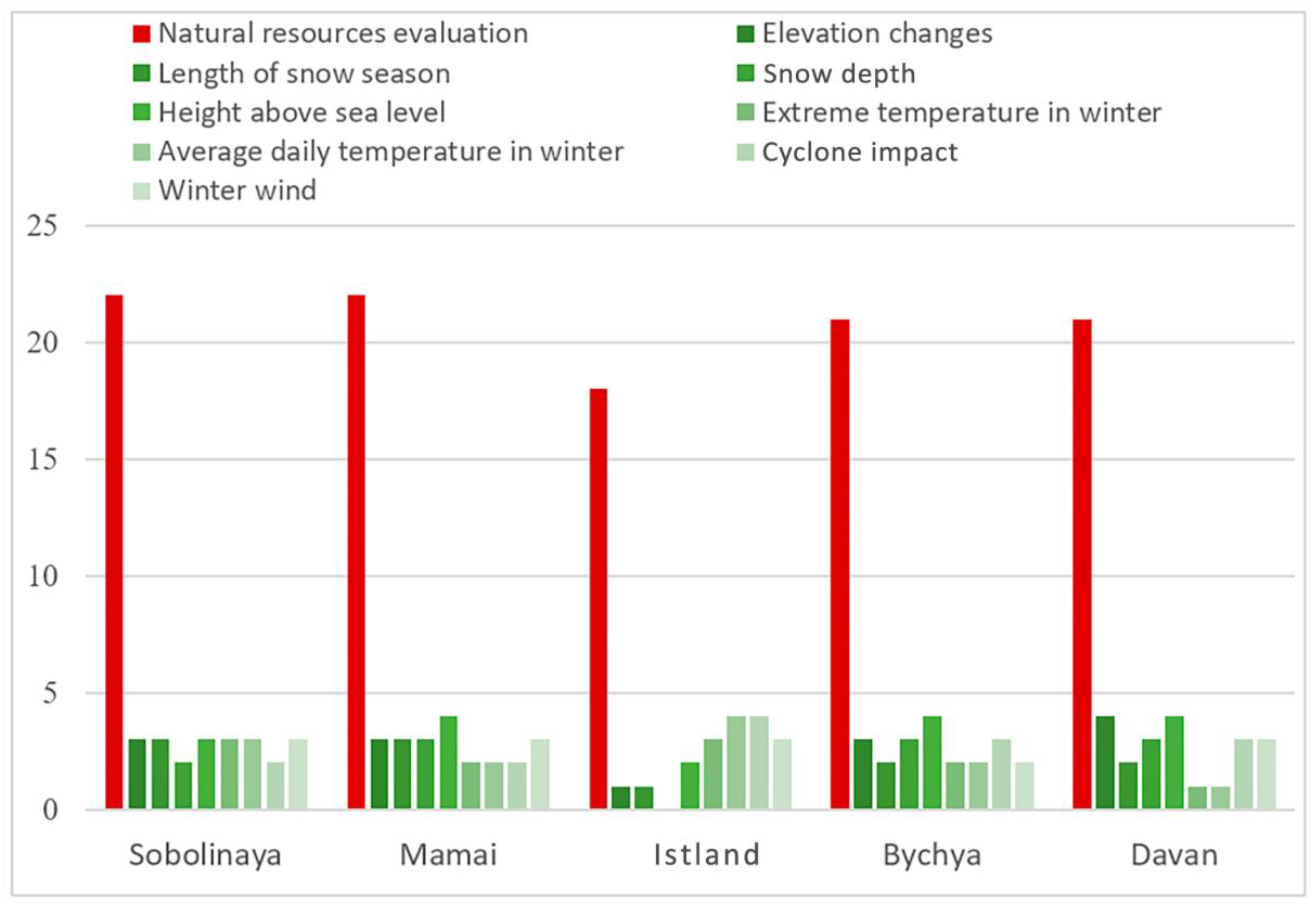
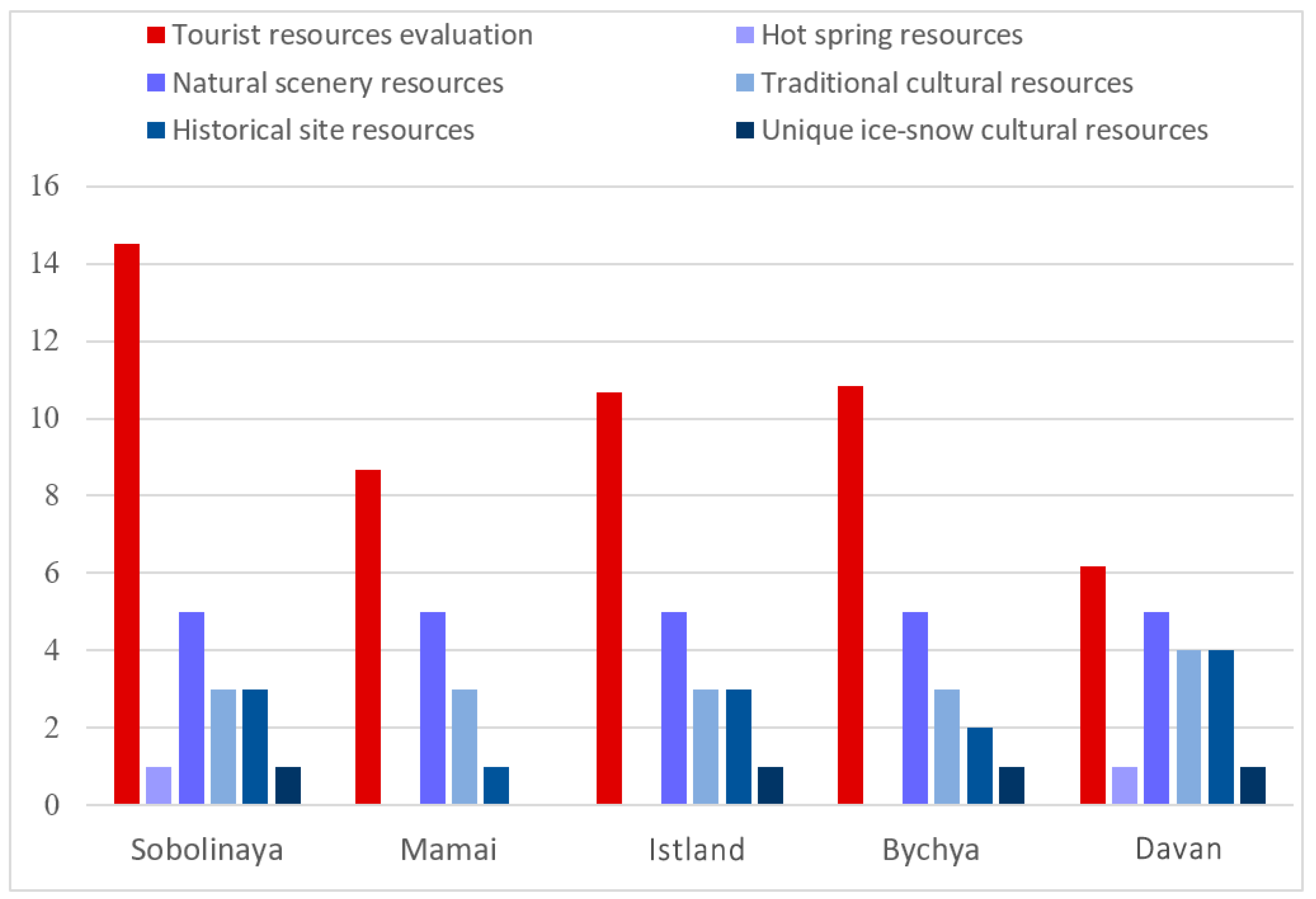
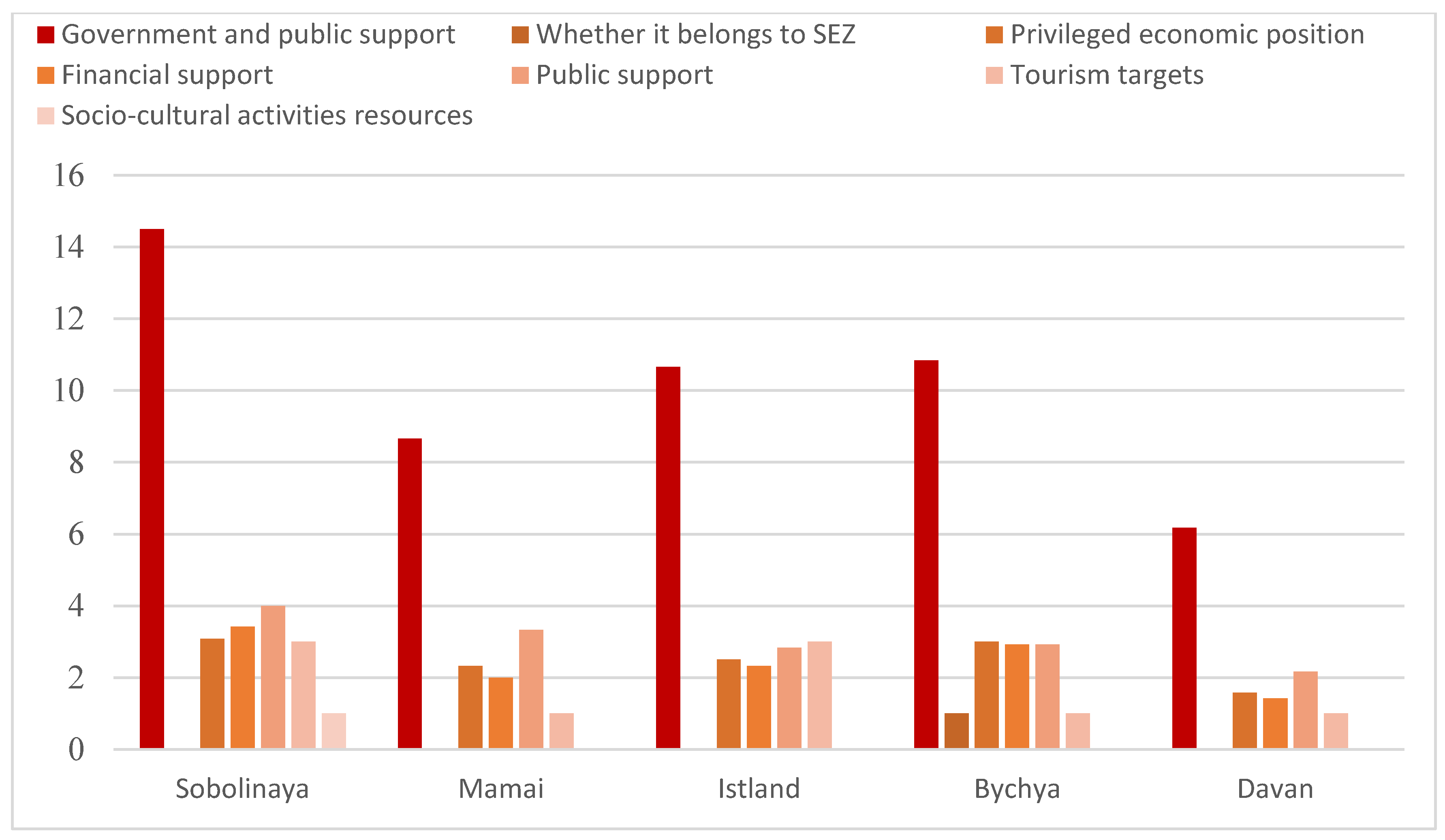


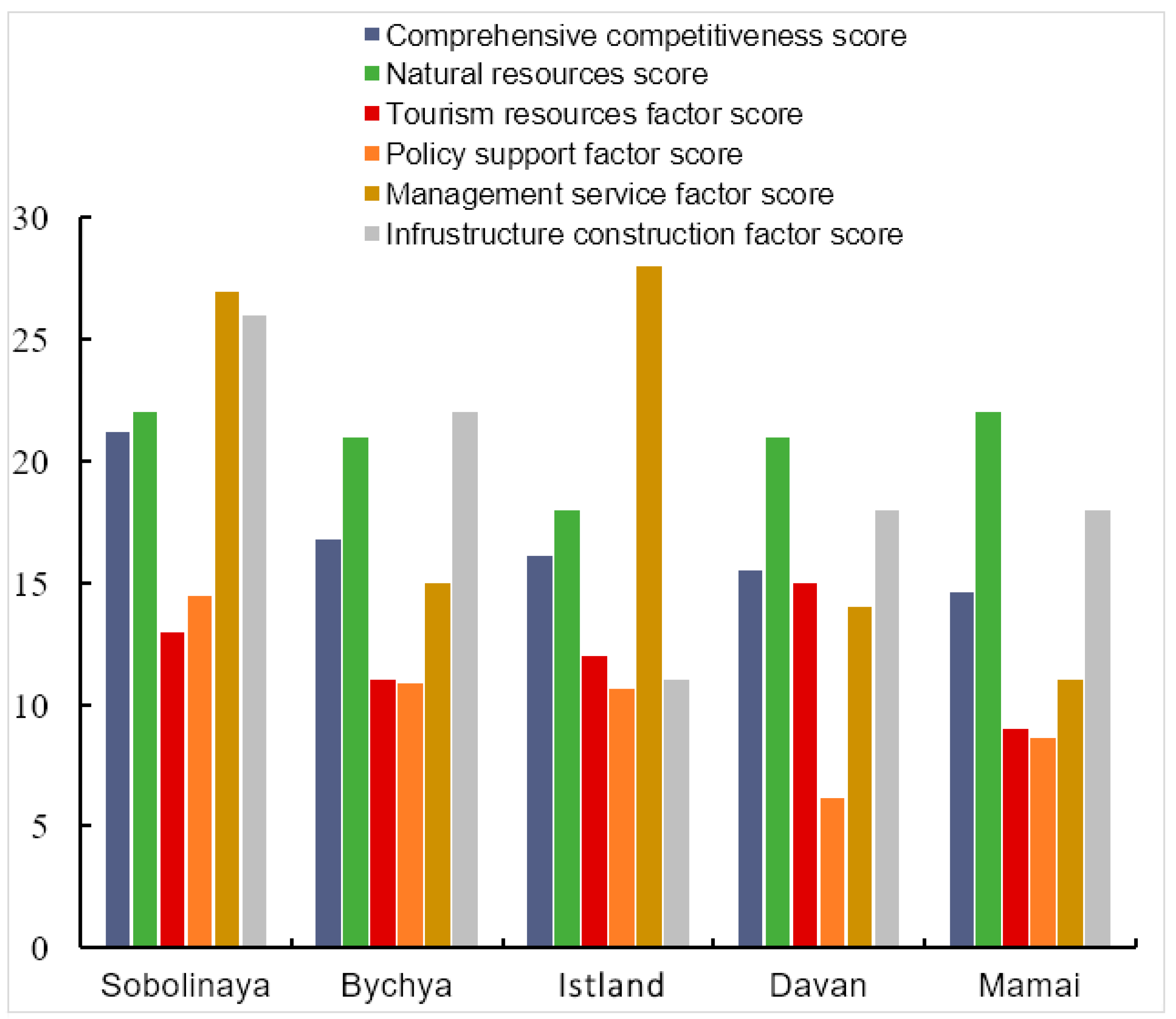
| Feature Layer | Indicator | Description |
|---|---|---|
| Natural resources | X1: Climate | Climatic conditions in terms of their comfort for skiing |
| X2: Hydrology | The amount of precipitation in the form of snow and its sufficiency for skiing throughout the season | |
| X3: Flora | Diversity of tree species in the forest community | |
| X4: Protected areas | Whether the resort is located in (or near) a protected area | |
| X5: Hot springs | Presence of hots springs | |
| X6: Natural landscape resources | The suitability of the landscape for skiing and snowboarding | |
| X7: External factors | Any other natural factors that can affect the tourist experience | |
| X8: Sites of cult | Construction (or a complex) for cultic or religious purposes | |
| Tourism resources | X9: Historical monuments | Presence of objects of historical value |
| X10: Objects of cultural heritage | Presence of objects of cultural value | |
| X11: Tourist information facilities | Availability of a visitor’s center, signs, and brochures. | |
| X12: Health improvement facilities | Ability and capacity to provide qualified medical care for tourists | |
| X13: Accommodation facilities | Capacity of tourist accommodation | |
| Government and public support | X14: Belonging to a special economic zone | Whether the tourist resort is part of the special economic zone |
| X15: Privileged economic position | Other government opportunities for a resort development (state programs, national projects). | |
| X16: Financial support | Financial assistance from government authorities. | |
| X17: Public support | Public support for further infrastructure construction and expansion. | |
| X18: Tourism targets | Targets set by the authorities for the planned inflow of tourists and parameters of tourist routes. | |
| X19: Socio-cultural activity resources | Availability of resources (or tourism facilities) that are of public importance (e.g., technical capacity for hosting major festivals). | |
| The scope of services provided and their management | X20: Geographical location (remoteness of a resort) | How easy it is to provide services to tourists in a resort, given the remoteness from major transportation routes. |
| X21: Transport accessibility | Description of the transport accessibility of the entire resort. | |
| X22: Transportation services | Convenience of transportation; the possibility of booking tickets. | |
| X23: Public catering facilities | How well-developed the catering network is. | |
| X24: Accommodation services | How convenient the hotel service is; the availability of the booking. | |
| X25: Sports centers | Availability and capacity of sports centers | |
| X26: Medical rescue centers | Availability and capacity of medical rescue centers | |
| X27: Parking lots | Availability and capacity of parking lots | |
| X28: Massage centers | Availability and capacity of massage centers | |
| X29: Sightseeing and excursion services | Organized sightseeing tours | |
| X30: Guide services | Tourist guide services | |
| X31: Safety management services | Control over the safety of slopes and lift functionality, as well as physical security within the territory | |
| Infrastructure construction | X32: Date of creation | The start date of construction of the infrastructure complex |
| X33: Historical (memorial) value | Whether the infrastructure facilities have a historical or memorial value | |
| X34: Artistic value | Whether the infrastructure facilities have an artistic value | |
| X35: Technological value | How technologically complex the infrastructure facilities are | |
| X36: Rarity/uniqueness | How unique the infrastructure facilities are | |
| X37: Authorship | Whether the infrastructure design belongs to a well-known architect/designer or a well-known company | |
| X38: Urban planning (ensemble) value | Whether the infrastructure complex has an ensemble value | |
| X39: Preservation of historical function | Whether the infrastructural complex has the function of preserving the historic function | |
| X40: Full lighting | Artificial lighting of ski slopes and resort area | |
| X41: Construction of ski area | At what state is the construction of the ski area (planned, ongoing, or completed) | |
| X42: The aesthetic appeal of the infrastructure | How aesthetically attractive infrastructure for tourists is |
Disclaimer/Publisher’s Note: The statements, opinions and data contained in all publications are solely those of the individual author(s) and contributor(s) and not of MDPI and/or the editor(s). MDPI and/or the editor(s) disclaim responsibility for any injury to people or property resulting from any ideas, methods, instructions or products referred to in the content. |
© 2023 by the authors. Licensee MDPI, Basel, Switzerland. This article is an open access article distributed under the terms and conditions of the Creative Commons Attribution (CC BY) license (https://creativecommons.org/licenses/by/4.0/).
Share and Cite
Yangutova, A.; Dong, S.; Cheng, H.; Xu, S.; Li, F.; Li, Z.; Zhang, M.; Li, J.; Bazarzhapov, T.; Boldanov, T. Assessing the Competitiveness of the Ski Resources around Lake Baikal (Russia) and Measures for Their Further Development. Sustainability 2023, 15, 10752. https://doi.org/10.3390/su151410752
Yangutova A, Dong S, Cheng H, Xu S, Li F, Li Z, Zhang M, Li J, Bazarzhapov T, Boldanov T. Assessing the Competitiveness of the Ski Resources around Lake Baikal (Russia) and Measures for Their Further Development. Sustainability. 2023; 15(14):10752. https://doi.org/10.3390/su151410752
Chicago/Turabian StyleYangutova, Ayana, Suocheng Dong, Hao Cheng, Shuangjie Xu, Fujia Li, Zehong Li, Menghan Zhang, Jingwen Li, Tcogto Bazarzhapov, and Tamir Boldanov. 2023. "Assessing the Competitiveness of the Ski Resources around Lake Baikal (Russia) and Measures for Their Further Development" Sustainability 15, no. 14: 10752. https://doi.org/10.3390/su151410752
APA StyleYangutova, A., Dong, S., Cheng, H., Xu, S., Li, F., Li, Z., Zhang, M., Li, J., Bazarzhapov, T., & Boldanov, T. (2023). Assessing the Competitiveness of the Ski Resources around Lake Baikal (Russia) and Measures for Their Further Development. Sustainability, 15(14), 10752. https://doi.org/10.3390/su151410752









